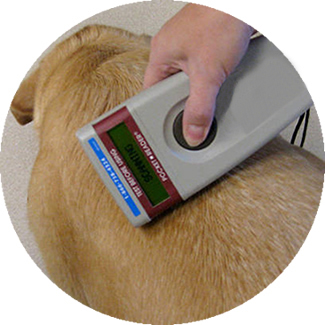- Top 5 Reasons to Microchip Your Pet:
• Only true permanent method of pet identification
• Lasts for the lifetime of your pet
• Quick and painless procedure, just like a vaccination
• Best chance of your pet returning to you should they go missing
• Microchipping is recommended by the AVMA, AAHA, ASPCA, SAWA, the Humane Society and others.
- What is a microchip?
A microchip is a tiny transponder about the size of a grain of rice that uses radio frequency waves to transmit a unique ID number associated with your pet. They're implanted just under the skin, between the shoulder blades.
- How does a microchip work?
The microchip itself does not have a battery or any other form of power supply. It is "passive." The "passive" microchip is activated only when it comes in contact with an "active" handheld scanner used by a trained, animal professional. The handheld scanner reads the radio frequency of the chip and displays your pet's unique ID number on the screen. The ID number is input into the data base registry to get your contact information. They contact you and you can be reunited with your lost pet.
- How does the Microchip Registry Work?
1. Pet Registered
Pet owners register their pets in FreePetChipRegistry™.

2. Pet Gets Lost
Microchip number is searched in FreePetChipRegistry™.

3. Owner Alerted
Found Pet Alert is started. Pet owner receives phone calls, emails, and text messages

4. Pet Goes Home
Lost pet and pet owner are reunited.

- Will the microchip ever wear out or have to be replaced?
Since there's no battery and no moving parts, there's nothing to wear out or replace. Microchips are designed to last your pet's lifetime.
- Why Microchip Your Pet?
Every year thousands of lost and abandoned animals are taken in by animal shelters and rescues. Unfortunately, some of these animals never make it home simply because they can't be identified. There is a solution. It's microchipping!
Because collar tags sometimes break or become illegible and tattooing can also become illegible, microchipping your pet is the only truly permanent method of identifying your pets with the information necessary to return them to you should they become lost. Providing your cat or dog with both tags and a microchip helps ensure a happy reunion if the unthinkable happens and your companion gets lost.
- How are pets microchipped?
A veterinary professional, rescue group or animal shelter will implant the microchip in your pet. The procedure is simple and similar to administering a vaccine or a routine shot. The microchip comes preloaded in a sterile applicator and is injected under the loose skin between the shoulder blades. The process takes only a few seconds, and your pet will not react any more than he would to a vaccination. No anesthetic is required.
- Is FreePetChipRegistry™ a Participating Pet Recovery Service Registry for the AAHA Universal Pet Microchip Lookup Tool?
Yes!
- Now that I have microchipped my pet, do I also need to register him in a database?
Yes! Simply microchipping your pet isn't enough - you need to register the microchip and your contact details into a database so your information can be found in the event you are separated from your pet. Wouldn't you want your pet's home details registered on the most reliable, free animal identification database in the world? It is the cheapest insurance you'll ever buy, because it's free for the life of your pet and can be used by anyone. No registration fee; no maintenance fees; no fee to update your contact information; no fees at all as long as you register your pet with FreePetChipRegistry.com.
- How much does it cost to register my pet?
Although many companies charge an annual fees to register pets, there is no cost to use FreePetChipRegistry™. You can register any brand of microchip, add as many pets as you like, and update your information for free online 24/7/365.
- If I register my pet into FreePetChipRegistry™, will I be solicited for anything?
FreePetChipRegistry.com maintains a strict non-solicitation policy. Your information will not be sold to any third parties, and other than opt-in pet insurance banners inside of your FreePetChipRegistry account, you will not be solicited for anything as a result of registering your pet(s) at FreePetChipRegistry.com.
- How do I complete an initial registration?
- Go the FreePetChipRegistry.com home page and click on the "Create an Account" button. It's at the top of the page.
- Step 1 of 2: Create Account (Fill out the required fields and click on the "Register Button" at the bottom of the home page. Make sure to make a record of your username and password!)
- Step 2 of 2: Add Your Pet (Fill out the required fields and click on the "Add Pet" button at the bottom of the page and you are done!)
- How do I update my contact information?
- Go the FreePetChipRegistry.com home page and click on the "Log In" button at the top of the page. Login using the Username and Password that you established. It was emailed to you when you registered your first pet.
- Click the "Account" button at the the top of the page and then the "Edit" button to update your contact information.
- Go the FreePetChipRegistry.com home page and click on the "Log In" button at the top of the page. Login using the Username and Password that you established. It was emailed to you when you registered your first pet.
- Click on the "Dashboard" button to update your pet information or to add or delete pets.
- Go the FreePetChipRegistry.com home page and click on the "Log In" button at the top of the page. Login using the Username and Password that you established. It was emailed to you when you registered your first pet.
- Click on the "Dashboard" button and then the "+ Add Pet" button
- Click the "Add Pet" button of the page and you are done!
Important Note: After registering your first pet, DO NOT use the "RESGISTER A PET" tab on the home page to add additional pets. In order to add additional pets you must first login under your Username and Password and then use the "+ Add Pet" button. That way, all of your pets are in a single account with a single Username and Password.
- Go the FreePetChipRegistry.com home page and click on the "Log In" button at the top of the page. Login using the Username and Password that you established. It was emailed to you when you registered your first pet.
- Click on the "Dashboard" button and then the "Delete" button and you are done!
- Go the FreePetChipRegistry.com home page and click on the "Log In" button at the top of the page. Login using the Username and Password that you established. It was emailed to you when you registered your first pet.
- Option 1: Delete your pet as described above. The person you want to transfer your pet to can then simply create their own account and add the pet.
- Option 2: Click the "Transfer" button and follow the instructions. The person you are transferring the pet to will then receive an email with instructions as how to complete the transfer.
No. That information is locked.
No. That information is locked.
To retrieve a forgotten password, at the top of the homepage click "Login" and then click "Forgot Password. "
Yes. There are three pet identification microchip frequencies in use 125 kHz, 128 kHz and 134.2 kHz. 134.2 kHz is the ISO (International Standards Organization) standard and is the primary frequency used worldwide. If your pet does not have an ISO 134.2 kHz microchip, you many need to get one for international travel. The ISO frequency of 134.2 kHz is the only frequency recommended by the AVMA, AAHA, HSUS, the ASPCA and many other pet organizations.
Yes. Because there are three microchip frequencies in use, a pet needs to be scanned with a "Universal Scanner". Universal scanners read all three microchip frequencies, regardless of who the manufacturer of the microchip is. Any shelter, rescue or veterinarian not using a universal scanner will miss microchips, making it harder for lost pets to reunite with their families.
Call the clinic or facility that implanted the microchip and they can look up the number in your pet's medical records. If you aren't sure where your pet was microchipped, or are not sure if you pet has a microchip, your local rescue, shelter or veterinarian can help. First, call to confirm that the organization has a "universal scanner" that reads all three microchip frequencies. Once you have your pet's microchip number, keep this information in your pet's records.
If your pet has multiple microchips, we recommend that you individually register each microchip. If your pet is lost and found, it is possible that that only one of the two microchips will be read. Therefore, it is important to keep each microchip registered and updated.
Microchip numbers typically come in three varieties and can look similar to these examples:
- 977000123456789
- OAO0757738
- 070285035
The first example above is an ISO 134.2 kHz microchip. ISO microchips always contain 15 numbers only. They always start with the number, 9. They cannot contain any letters, spaces, dashes or symbols.
The second and third examples above are non-ISO microchips (125 kHz or 128 kHz frequency). They always have either nine or ten digits and may contain a mixture of numbers and letters. They should not be registered with dashes, spaces or any other symbols.
However, don't worry. If you try to register an invalid microchip number, you will instantly receive a message telling you that the ID is not valid and to try again. If you are unsure of what your pet's correct microchip ID is, contact the facility where you adopted your pet, or where you had the microchip implanted.
No. IS011784 FDX-B is not a microchip number. That number is in indication that your pet has a microchip that meets the International Standards Organization (ISO) standard 11784 FDX-B and can be used for travel to most countries around the world. However, it is not a microchip number.
No. A microchip is a backup to collar tags, not a replacement. Your pet should continue to wear his collar tags. The most important information on your pet's collar tag is your telephone number.
No. You cannot get information on a lost pet's location directly from the microchip. It is only when your lost pet is found, scanned, and searched in an online registry that someone will be able to contact you. This is why it is critical to keep your contact information current in an online microchip registry.
Yes. When you transfer the pet registration, you have the option to remain as the Secondary Contact. However, you also have the option to stay on the pet's record as a pet's Primary Permanent Rescue Contact. This way, if the pet is lost, both you and the new adopter will be notified when a lost pet is found.
Below are some helpful links for determining what you need to do in order to take your pet to another country:
- National Center for Import and Export (NCIE) A part of the USDA's Animal and Plant Health Inspection Service (APHIS), this organization regulates the import and export of animals in the US.
- USDA Pet Export Information From the NCIE, this page contains specific information - including general instructions and links to further information - about the procedures for taking pets abroad.
- Regulations by Country This page contains links to regulations in place in more than 100 countries.
Absolutely!
From accidents to illnesses, pet insurance helps cover unexpected veterinary expenses. Our partner, Fetch Pet Insurance, provides the most complete coverage for dogs & cats – so you never have to compromise on vet care for your pets. With Fetch, you can get paid back for unexpected vet bills for accidents, illnesses, emergency vet visits, prescription meds and supplements & more. Learn more or claim your free, no-obligation quote here.





